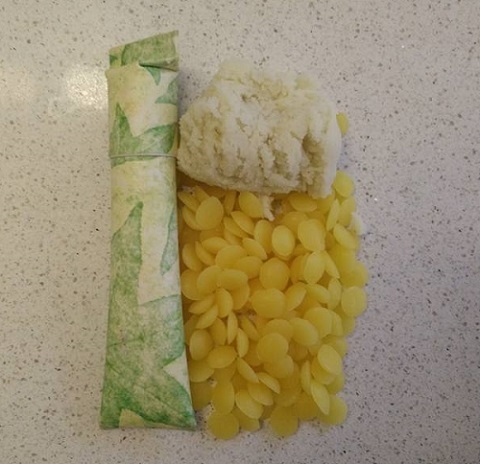How to make lip balm

Make lip balm with shea butter, beeswax, avocado oil and then store in compostable paper tubes! (Credit: Lindsay Coulter)
Pucker up!
Make your own lip balm--something many of us use daily. This simple, effective recipe contains no toxic chemicals, so it's healthy for your skin AND the planet.
Lip balm recipe
Time needed: ten minutes
Shelf life: approximately six months
5 ml (1 tsp) organic, fair trade shea butter or cocoa butter
15 ml (1 Tbsp) avocado oil
15 ml (1 Tbsp) local beeswax (grated or pastilles) or soy wax
Optional: 5 drops essential oil (e.g., peppermint, lime or grapefruit) and/or 1 drop Vitamin E oil.
Put about 50 ml (1/5 cup) of water into a small pot on low heat. Combine first three ingredients in a small metal bowl. Create a double boiler by placing the bowl on top of the pot. Stir ingredients until melted. Remove from heat. Add optional ingredients. Stir. Let cool. Store in air-tight container: Choose reusable tins, glass or look for paper tubes to avoid plastic.
Ingredient properties (find them at health food stores or most grocers):
Shea butter: Contains vitamins A and D (revitalizes skin), E (oxygenates) and F (keeps skin young and supple). Also protects skin from sun (SPF 3 to 6) and wind damage.
Cocoa butter: An antioxidant and emollient made from cocoa beans (a vegetable fat). Helps lubricate and smooth skin by locking in moisture.
Avocado oil: Full of beta carotene, vitamins C and E (SPF 4 to15).
Beeswax: Acts as a binding agent. Won't clog pores. Safe for all skin types. (Vegan? Try soy wax instead.)
Vitamin E (a.k.a. tocopheryl acetate): A powerful antioxidant that combats free radicals and oxidation damage. Also helps moisten and soften skin.
Once you try this double boiler process to melt oils and wax, try other lip balm recipes -- even create your own! Research the properties of various butters and oils here.
Why make lip balm?
Petrolatum (a.k.a. mineral oil jelly), found in many lip balms, hair care products, soaps and skin care products is one of our Dirty Dozen ingredients to avoid. It's used as a barrier to lock moisture into skin. It's also a petrochemical sometimes contaminated with cancer-causing polycyclic aromatic hydrocarbons. The European Union considers it a carcinogen and restricts its use in cosmetics.
Protect your lips from the elements. Make extra for gifts. Safe for kids, too. (Note: People with nut allergies may have an adverse reaction to shea butter because it comes from the nut of the karite tree. Use cocoa butter instead.)
Please share your review in the comments below.
Sincerely,
Lindsay Coulter, a fellow Queen of Green
Hey! Want more DSF? Join David Suzuki on Facebook

David Suzuki's Blog
- David Suzuki's profile
- 247 followers



